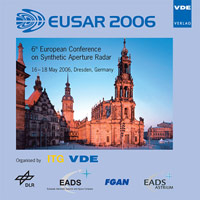Retrieval of 2-D current and ocean wave information using Tandem-X in a squinted split antenna mode configuration
Konferenz: EUSAR 2006 - 6th European Conference on Synthetic Aperture Radar
16.05.2006 - 18.05.2006 in Dresden, Germany
Tagungsband: EUSAR 2006
Seiten: 4Sprache: EnglischTyp: PDF
Persönliche VDE-Mitglieder erhalten auf diesen Artikel 10% Rabatt
Autoren:
Schulz-Stellenfleth, Johannes; Lehner, S. (Remote Sensing Technology Institute, German Aerospace Center (DLR), Germany)
Hajnsek, Irena (Microwave and Radar Institute , German Aerospace Center (DLR), Germany)
Inhalt:
It is well known that along track interferometric SAR systems (ATI) are able to provide information on ocean surface currents. For example interferograms acquired during the Shuttle radar topography mission (SRTM) were used at DLR to measure currents in the river Elbe. The ocean current information is important for many practical applications like, e.g., monitoring of sediment transport in coastal areas, optimal siting of current turbines, or forecast of oil slick drift. It has been shown that the TerraSAR-X split antenna mode can be expected to provide current information comparable to SRTM data, i.e., the ocean current component in the antenna look direction on a kilometre scale. This is already valuable information and complements the traditional in situ current measurements very well. However, there is still demand for two-dimensional (2-D) ocean current vectors to get a more complete picture of the 2-D spatial structure of the current field in particular in areas with strong spatial dynamics of the current direction. The presentation will give an overview of a proposal to carry out an experiment in the framework of the Tandem-X mission with the objective to retrieve additional 2-D information on currents and ocean waves. The idea is to operate both SAR instruments in split antenna mode with large squints of one or both satellites. Using this flight configuration it is expected that it will be possible to gain information on 2-D ocean current vectors. Due to the lack of suitable instruments this technique has never been applied using spaceborne platforms before. First experiments with airborne systems demonstrating the potential of the approach have been conducted. Apart from new current field information the proposed configuration enables the derivation of 2-D information on near surface wind fields applying the standard scatterometer approach. Furthermore it is expected that the approach will provide new information on the so called modulation transfer function (MTF) for ocean waves, which is one of the key factors in SAR ocean wave spectra retrieval schemes. The presentation will give a summary of the main technical issues including simulation studies showing the impact of different key parameters, e.g., the squint angle. The potential as well as limitations of the approach will be discussed.


